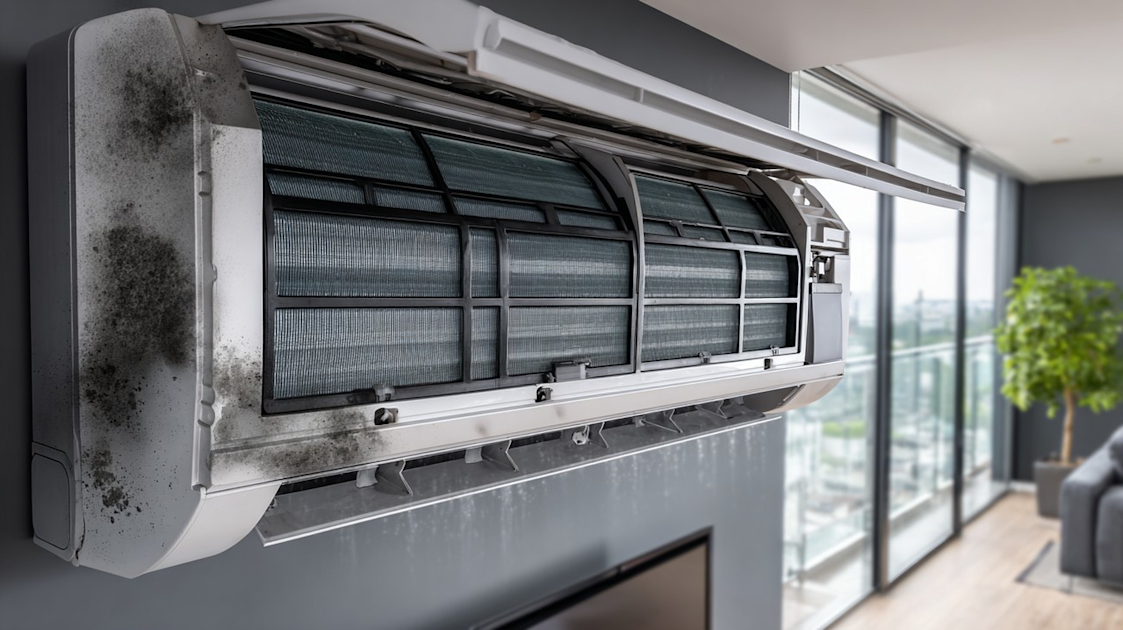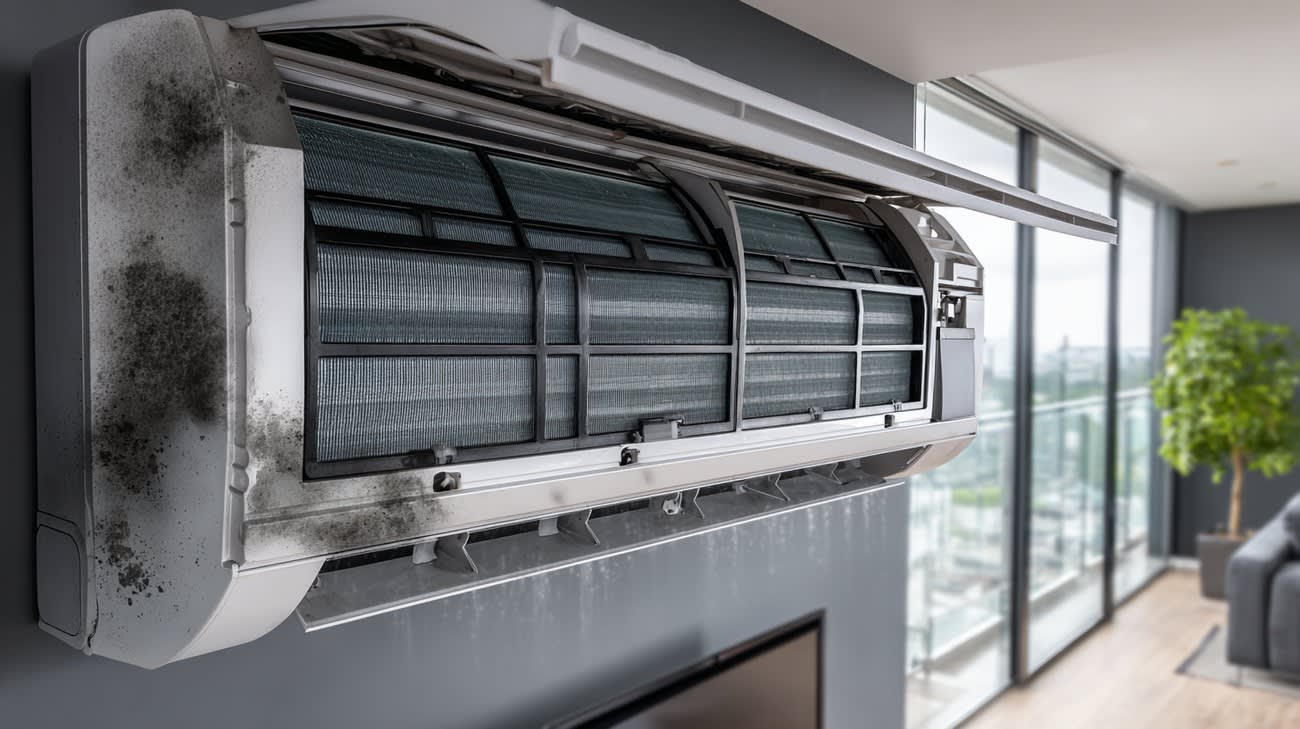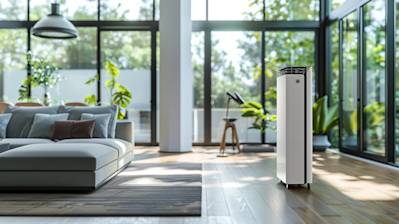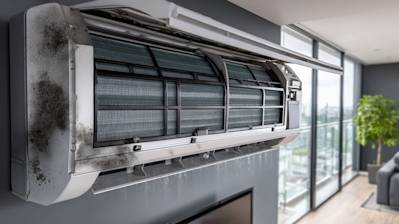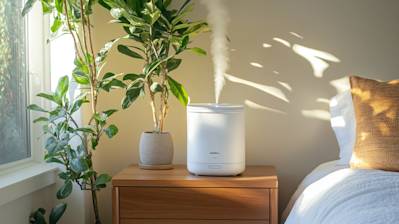The discovery of black mold in your air conditioner can be concerning, not only due to the potential damage it can cause to your HVAC system but also because of the serious health risks it poses. This article will delve deeply into what black mold is, why it forms in air conditioners, how you can identify it, and, most importantly, how you can prevent and remove it from your home.
What is Black Mold?
Black mold, or Stachybotrys chartarum, is a type of fungus that thrives in damp, warm environments. It is typically dark green or black in color and known for producing allergens and irritants. While not all black mold secretes dangerous mycotoxins, its potential to harm health through spores makes it a nuisance when it begins growing indoors.
Why Does Black Mold Form in Air Conditioners?
Your air conditioner can inadvertently create the perfect environment for black mold growth due to several reasons:
- Moisture Accumulation: Air conditioners remove moisture from the air, leading to condensation that can accumulate in the unit.
- Dark, Hidden Spaces: Mold thrives in dark areas, and the internal components of air conditioners are often concealed and rarely exposed to light.
- Inadequate Ventilation: Poor ventilation can trap humid air, further exacerbating mold growth.
How to Identify Black Mold in Your Air Conditioner
Being able to recognize the presence of black mold early can prevent it from causing severe damage. Here are some signs to look out for:
- Musty Odor: A persistent, musty smell when the air conditioner is running can be an early indication of mold.
- Visible Growth: Dark spots or fuzz around your air conditioner vents or panels are clear indicators.
- Health Symptoms: Increased allergic reactions, such as sneezing, coughing, or skin rashes, could result from mold spores circulating in the air.
Health Risks Associated with Black Mold
Exposure to black mold can lead to various health issues, particularly for individuals with respiratory problems, allergies, or compromised immune systems. Potential health effects include:
- Respiratory issues like asthma attacks and chronic coughing
- Skin irritation and red, itchy eyes
- Headaches and fatigue
Steps to Remove Black Mold in Air Conditioners
Addressing a black mold problem in your air conditioner quickly is crucial. Here’s how you can tackle the issue:
- Turn Off the AC: Always start by turning off the air conditioning system to prevent further spread of mold spores.
- Wear Protective Gear: Use masks, gloves, and eye protection to minimize exposure.
- Remove and Clean Parts: Dismantle removable parts like the filters and panels, and clean them using a mixture of water and detergent.
- Disinfect with Mold Killer: Apply a commercial mold remover or a homemade solution of vinegar or baking soda to affected areas.
- Allow to Dry: Ensure all parts dry completely before reassembly, as moisture will invite mold back.
Prevention Tips to Keep Mold Away
Once you've cleaned your AC unit, ongoing maintenance is key to preventing a recurrence of black mold. Here are some prevention tips:
- Regular Cleaning: Clean your AC filters and ducts monthly to prevent moisture and dust buildup.
- Professional Inspection: Have your system professionally inspected and cleaned annually.
- Ensure Proper Ventilation: Improve airflow in your home by using dehumidifiers and ensuring windows and doors are sealed properly.
- Monitor Humidity Levels: Keep indoor humidity below 50% by using a hygrometer.
When to Call a Professional
If the mold infestation is extensive, or you're unsure about handling chemicals safely, it’s best to call a professional mold removal service. Professionals have the tools and expertise to effectively and safely eliminate mold while preventing its return.
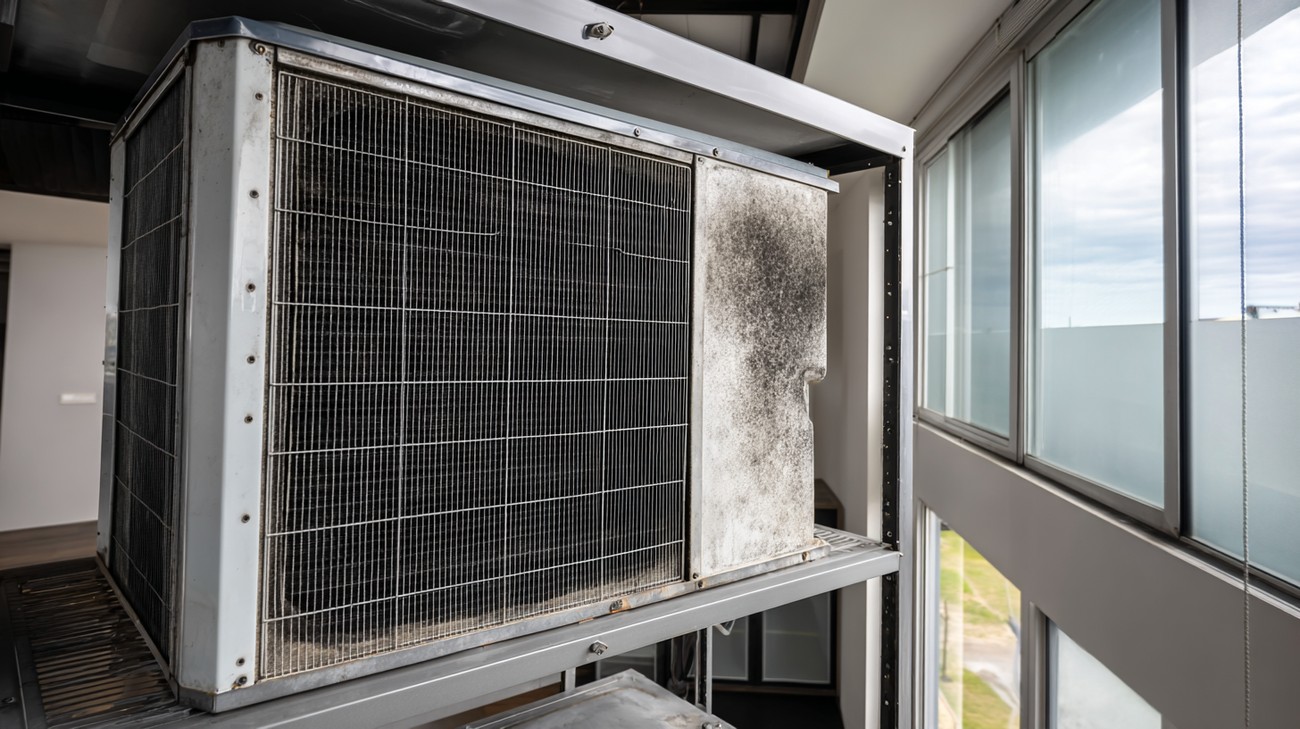
Frequently Asked Questions
What health risks are associated with black mold in air conditioners?
Exposure to black mold can lead to a variety of health issues, particularly for those with allergies, asthma, or weakened immune systems. Black mold spores circulated through an air conditioner can cause respiratory problems, including coughing and sneezing, irritation of the eyes and throat, and in severe cases, chronic fatigue, and headaches. Prolonged exposure to black mold may exacerbate existing respiratory conditions and even lead to serious lung infections for some individuals. It's essential to address black mold in an air conditioner swiftly to safeguard indoor air quality and health.
How can I identify black mold in my air conditioner?
Identifying black mold in an air conditioner typically involves a combination of visual and olfactory inspections. Visually, black mold appears as slimy, dark greenish-black patches that may be found inside the air conditioner vents or on the evaporator coil. If there's a musty odor emanating from your air unit when it runs, that can also be a strong indicator of mold presence. For definitive identification, it might be necessary to have a professional conduct a thorough inspection or test mold samples from the air conditioner, especially if health symptoms are present.
Can black mold in an air conditioner affect indoor air quality?
Definitely. Black mold in an air conditioner can significantly degrade indoor air quality. As the air conditioner circulates air throughout your home, it can also disperse mold spores, leading to widespread mold exposure beyond the immediate vicinity of the unit. This elevated concentration of mold spores in the air can irritate the respiratory system, cause allergic reactions, and create a persistently damp, musty, and uncomfortable atmosphere within enclosed spaces.
What should I do if I suspect black mold in my air conditioner?
If you suspect black mold in your air conditioner, it's essential to act quickly to avoid potential health risks. Start by turning off the system to prevent further spread of spores. Next, visually inspect the accessible parts of the air conditioner for signs of mold. While simple cleaning can sometimes resolve minor cases, it's often advisable to contact a professional HVAC technician or a mold remediation specialist for a thorough examination and effective removal. Comprehensive cleaning by professionals will ensure the entire system, including hard-to-reach areas, is free from mold contamination.
How often should I clean my air conditioner to prevent black mold?
Regular maintenance of your air conditioner is key to preventing black mold growth. Generally, it's advisable to clean your air conditioner thoroughly at least once or twice a year. This cleaning should include washing or replacing the air filters, wiping down coils, and ensuring that the drainage pan is clear of water accumulation. In high humidity regions, more frequent cleaning might be necessary. Beyond these regular cleanings, always be attentive to signs of mold growth and address any moisture issues immediately to prevent mold from taking hold.
Are there preventive measures to stop black mold from forming in air conditioners?
Preventing black mold from forming in air conditioners requires a combination of regular maintenance and specific preventive measures. Ensure that the air conditioner is draining properly to minimize moisture buildup, and keep humidity levels in your home below 60%. Use a dehumidifier if necessary. Regularly change or clean the unit's filters, and consider using mold-inhibiting products designed for HVAC systems. You could also invest in an air conditioner with built-in UV lights, as these can effectively kill mold spores before they proliferate.
Is it safe to use an air conditioner with black mold?
Using an air conditioner with black mold is not safe due to the health risks associated with inhaling mold spores. The air circulated throughout your home will likely be contaminated, posing a threat to you and your family’s health, especially for individuals with pre-existing respiratory conditions. If you discover black mold in your air conditioner, it's crucial to cease its usage until the mold is professionally removed and the unit is thoroughly cleaned.
How can I clean black mold from my air conditioner myself?
If you choose to clean black mold from your air conditioner yourself, proceed with caution. First, ensure the unit is turned off and unplugged. Wear protective gear, including gloves and a mask, to avoid direct exposure to mold and spores. Use a mixture of water and mild detergent to scrub down visible mold patches, or consider commercial mold removers. Thoroughly clean filters, coils, and other accessible components. Rinse any detergent residues, dry all components completely, and reassemble the unit. However, if the mold infestation is extensive, it's best left to professionals to ensure complete removal and avoid any health risks.
Should I replace my air conditioner if it has black mold?
Replacing your air conditioner because of black mold isn't always necessary unless the contamination is extensive and irreparable, or the unit is outdated and inefficient. In most cases, a thorough cleaning and proper remediation by professionals can salvage the unit. However, if mold reoccurs frequently even after cleaning, or if the air conditioner is old and maintenance costs exceed the unit's value, replacement might be a prudent choice. Newer models typically offer improved moisture control features and mold resistance, making them a good investment for long-term air quality.

Troubleshooting Guide
Black mold in your air conditioner can be a pesky issue, not only causing your system to run inefficiently but also potentially impacting your health. Let’s dive into common problems, their symptoms, and how you can tackle them head-on.
1. Musty Odor from Vents
Symptoms: A persistent musty or earthy smell whenever the air conditioner is running.
Likely Causes: Mold or mildew growth within the air conditioning system or ducts.
Fixes:
- Turn off the air conditioner and unplug it.
- Open the unit and inspect visible components for mold.
- Clean removable parts such as the filter or evaporator coil with a mixture of bleach and water (1 cup bleach per gallon of water) to kill mold.
- Wipe down the interior with the same solution, ensuring all mold is removed.
- Allow all parts to dry completely before reassembling the unit.
When to Call a Professional: If the musty odor persists despite cleaning or if the mold is extensive and difficult to reach.
Prevention Tips: Regularly clean and replace air filters, and schedule annual maintenance to keep everything in tip-top shape.
2. Visible Mold Growth
Symptoms: Black or dark patches inside the unit or around vents.
Likely Causes: Moisture buildup due to condensation, poor ventilation, or a clogged drainage system.
Fixes:
- Remove the cover of your air conditioning unit.
- Use a brush with bleach solution to scrub off visible mold.
- Check and unclog drainage pipes ensuring water flows freely.
- Increase airflow by ensuring the space around the unit is clear.
When to Call a Professional: If the mold has spread to ductwork beyond your reach, or if you’re unable to safely access certain areas of the unit.
Prevention Tips: Ensure all parts of the AC unit are well-ventilated and maintain proper drainage paths.
3. Water Leaks
Symptoms: Water pooling around the air conditioning unit or dripping from vents.
Likely Causes: Clogged condensate line or overflowing drip tray leading to excess moisture and mold growth.
Fixes:
- Switch off the unit and locate the condensate drain line.
- Use a wet-dry vacuum to clear any clogs in the line.
- Empty and clean the drip pan, using a bleach solution to sanitize it.
- Replace any damaged pads or parts that contribute to excess moisture.
When to Call a Professional: If you cannot locate or access the drain line or if the issue recurs frequently.
Prevention Tips: Regularly check and clean the drip pan and condensate line to prevent blockages.
4. Decreased Airflow
Symptoms: Weak airflow even when the fan is set on high.
Likely Causes: Mold blocking the air filter or within the ductwork, reducing the efficiency of air passage.
Fixes:
- Inspect and replace dirty or moldy air filters.
- Ensure vents and returns are clear of obstructions.
- Consider duct cleaning if buildup is suspected within ductwork.
When to Call a Professional: When airflow doesn’t improve after filter replacement or if you suspect mold in the ducts.
Prevention Tips: Change filters every 1-3 months and ensure vents are always open and unobstructed.
5. Allergic Reactions
Symptoms: Sneezing, coughing, or itching when the air conditioner is on, especially for allergy sufferers.
Likely Causes: Airborne mold spores circulated by the air conditioning system.
Fixes:
- Replace air filters with high-efficiency particulate air (HEPA) filters to trap spores.
- Regularly clean unit components to prevent mold buildup.
- Use an air purifier in the home to reduce airborne spores.
When to Call a Professional: If symptoms persist or worsen, as this may indicate a severe mold problem needing expert treatment.
Prevention Tips: Regular maintenance of your HVAC system and using quality air filters can minimize mold spores in the air.
By staying on top of maintenance and addressing small problems before they escalate, you can keep your air conditioner mold-free and healthy. Always prioritize safety and call in a professional when in doubt!

Common Mistakes to Avoid
Dealing with black mold in your air conditioner can be a daunting task, especially when you're not sure what to look out for. Many people unknowingly make mistakes that either exacerbate the issue or fail to resolve it completely. Let's explore some of the most common pitfalls, why they occur, and how you can avoid them.
1. Ignoring the Warning Signs
Why This Happens: Sometimes, we might attribute unusual smells or minor allergic reactions to anything but mold. It's easy to overlook these signs when you're not aware that they might indicate a problem.
How to Avoid It: Regularly check and maintain your air conditioning unit. Pay attention to unusual smells, visible mold, or health symptoms that seem to worsen when the AC is running.
What to Do If You’ve Made This Mistake: Once aware, inspect your AC unit thoroughly for mold, and consider hiring a professional to assess the situation. Act quickly to address any issues to prevent health risks or further damage.
Expert Recommendation: Set reminders for regular AC check-ups and familiarize yourself with common mold indicators.
2. Using Bleach to Clean Mold
Why This Happens: Many believe that bleach is a universal solution for mold removal due to its strong chemical nature.
How to Avoid It: Understand that while bleach might remove surface mold, it doesn't address mold spores deeply embedded in porous surfaces. Instead, use specialized products designed for mold removal.
What to Do If You’ve Made This Mistake: Re-clean the affected areas with appropriate mold removal solutions. Consider removing and replacing heavily infested materials, such as filters and insulation.
Expert Recommendation: Use an EPA-registered mold remover and equip yourself with protective gear, such as gloves and masks, during the cleaning process.
3. Neglecting Regular Maintenance
Why This Happens: Life gets busy, and regular AC maintenance might fall by the wayside, especially when the unit seems to be functioning correctly.
How to Avoid It: Schedule regular maintenance checks with a professional at least twice a year, focusing on cleaning and inspecting the interior components of the unit.
What to Do If You’ve Made This Mistake: If maintenance has been neglected, arrange for a thorough inspection and cleaning immediately. This will help catch issues early and reduce mold recurrence.
Expert Recommendation: Make use of smartphone apps or calendar alerts to remind you of these necessary maintenance tasks.
4. Overlooking Humidity Control
Why This Happens: Homeowners often forget that humidity control plays a crucial role in preventing mold growth.
How to Avoid It: Use dehumidifiers in areas prone to high humidity, such as basements or poorly ventilated rooms. Ensure your AC is effectively managing indoor humidity.
What to Do If You’ve Made This Mistake: Adjust settings on your air conditioner to optimize humidity control. Consider investing in standalone dehumidifiers if necessary.
Expert Recommendation: Aim for indoor humidity levels between 30-50% to minimize mold risk.
5. DIY Mold Removal Without Proper Knowledge
Why This Happens: In an effort to be cost-effective, many homeowners attempt DIY mold removal without understanding the full scope of the issue.
How to Avoid It: Only attempt to clean small areas of mold yourself if you feel confident and have done thorough research. Always consult professionals for large infestations.
What to Do If You’ve Made This Mistake: If your DIY attempt was unsuccessful, or if the problem has worsened, call a professional mold remediation service to ensure complete and safe removal.
Expert Recommendation: Prioritize safety and thoroughness over cost by hiring certified mold professionals, especially for significant infestations.
6. Improperly Sealing Moldy Ducts
Why This Happens: Some may try to seal ducts themselves to prevent mold spread, potentially trapping moisture and mold inside.
How to Avoid It: Ensure proper cleaning and drying of ducts before sealing them. Use materials and techniques recommended for HVAC systems.
What to Do If You’ve Made This Mistake: Have a professional review and properly clean and seal your ductwork to mitigate ongoing mold issues.
Expert Recommendation: Allow professionals to assess and execute duct sealing after thorough cleaning to ensure compliance with HVAC standards.
By understanding these common mistakes and how to avoid them, you'll protect both your health and your home from the detrimental effects of black mold in your air conditioner. Remain vigilant and proactive, and when in doubt, consult with an expert to guide you through the process.

